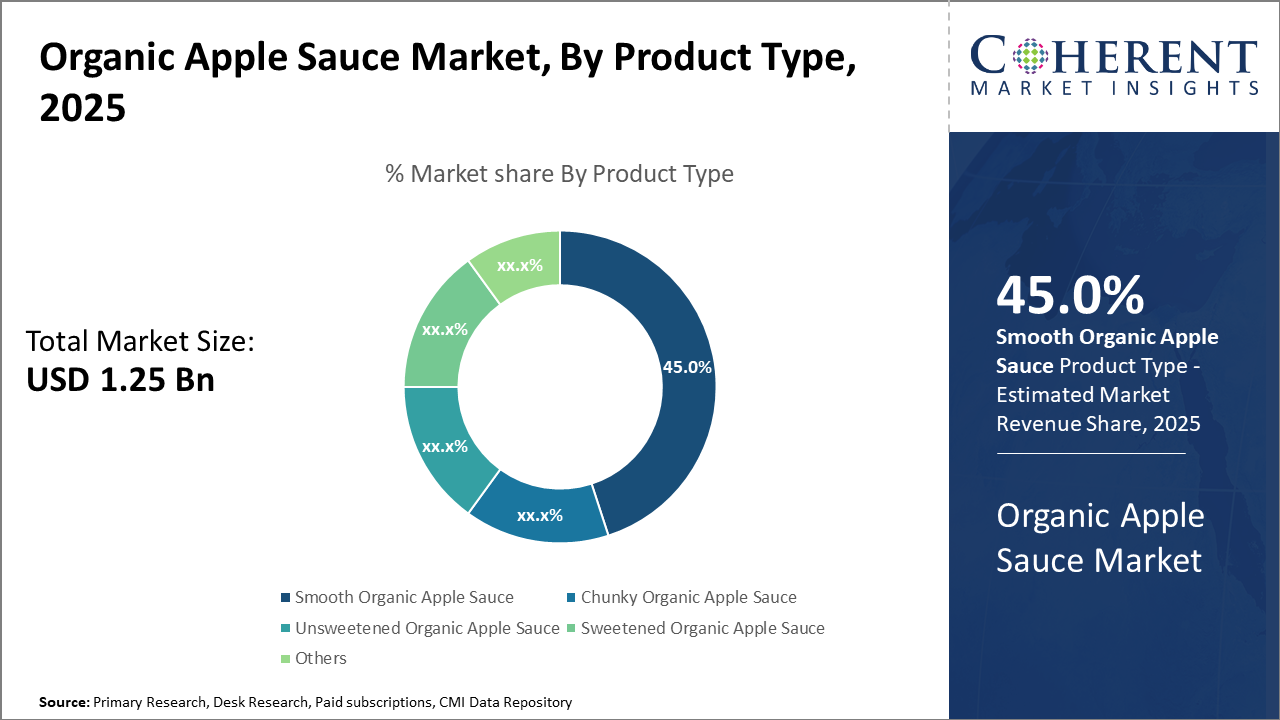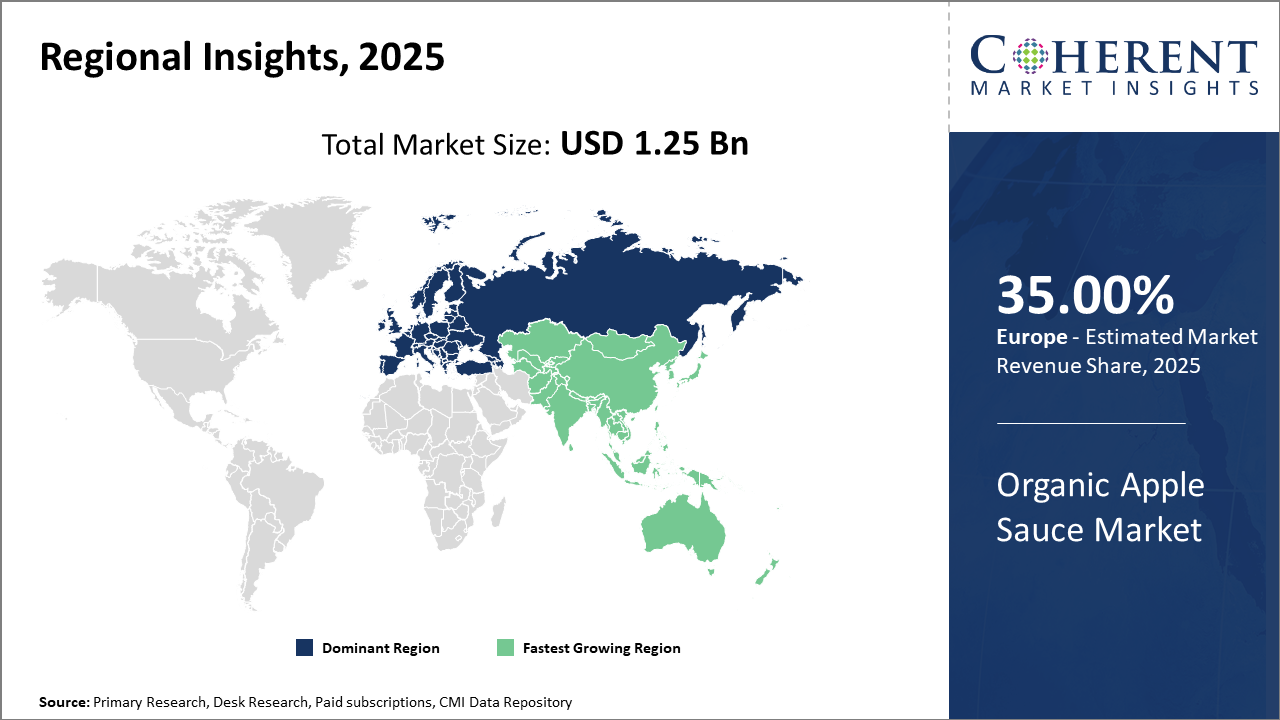Organic Apple Sauce Market Size and Forecast – 2025 – 2032
The Global Organic Apple Sauce Market size is estimated to be valued at USD 1.25 billion in 2025 and is expected to reach USD 2.10 billion by 2032, exhibiting a compound annual growth rate (CAGR) of 7.8% from 2025 to 2032.
Global Organic Apple Sauce Market Overview
Organic apple sauce products are made from organically grown apples that are free from synthetic pesticides, fertilizers, or genetically modified ingredients. These products are typically processed using minimal heat to preserve natural flavor, color, and nutrients. Available in a variety of textures (smooth, chunky, unsweetened, and flavored), organic apple sauces cater to both children and adults as a natural snack or cooking ingredient. Many brands also offer BPA-free packaging and shelf-stable pouches for convenience. The segment is witnessing innovations such as no-added-sugar formulas, inclusion of superfruits (like berries or mango), and certified USDA Organic or EU Organic labeling to meet clean-label and health-conscious consumer demands.
Key Takeaways
Smooth Organic Apple Sauce dominantly contributes to market revenue, accounting for nearly 45% market share, benefiting from its broad application in baby food and convenience meals. Chunky variants are progressively growing owing to consumer interest in textured products.
Online retail channels offer the fastest growth trajectory, backed by increasing consumer inclination to purchase specialty organic foods through digital means.
Europe holds a commanding lead with substantial market share due to stringent organic certification standards supporting premium product demand. North America shows robust growth influenced by rising health-conscious consumer bases and innovation from leading market companies.
Asia Pacific reveals strong growth potential with expanding retail infrastructure and government initiatives promoting organic agriculture, especially in China and India.
Organic Apple Sauce Market Segmentation Analysis

To learn more about this report, Download Free Sample
Organic Apple Sauce Market Insights, By Product Type
Smooth Organic Apple Sauce dominates the market share. This segment remains preferred due to its wide applicability in infant nutrition and as a versatile ingredient in culinary uses. The Smooth variant's texture and purity appeal strongly to health-conscious consumers, driving its sustained dominance. The Chunky Organic Apple Sauce is the fastest-growing subsegment as consumer interest shifts towards textured and artisanal products, emphasizing a natural eating experience. Unsweetened and Sweetened types cater to niche consumer demands, balancing health and flavor preferences.
Organic Apple Sauce Market Insights, By Packaging Type
Jars and Bottles account for the dominating market share, favored for their eco-friendly nature and consumer convenience, particularly in retail and household settings. Their reusable and recyclable qualities align with growing sustainability trends. Single-Serve Packs represent the fastest-growing subsegment, driven by the rising preference for portability, especially among millennials and health-conscious consumers demanding on-the-go options. Pouches appeal to cost-sensitive buyers and newer moms due to ease of use and portion control.
Organic Apple Sauce Market Insights, By Distribution Channel
Hypermarkets hold the largest share, benefitting from widespread consumer access and bulk buying advantages. They also serve as primary platforms for the launch and growth of branded organic apple sauce offerings. Online Retail is the fastest-growing channel, reflecting a significant market shift propelled by e-commerce growth and increased consumer digital literacy. Specialty Stores cater to niche organic and health-food customers, maintaining steady growth through curated product ranges. Convenience Stores, while smaller in market share, are expanding in urban centers with rapid consumer lifestyle changes. ‘Others’ includes direct sales and farmer markets, pertinent to localized demand pockets and organic community outreach.
Organic Apple Sauce Market Trends
The Organic Apple Sauce market trends reveal a pronounced shift towards innovation in natural preservation methods, with cold-pressed and fermented apple sauce variants gaining 20% more traction year-on-year since 2024.
Online platforms continue to disrupt traditional retail, contributing significantly to market revenue through targeted digital campaigns and subscription-based sales models that ensure consistent consumer engagement.
Furthermore, regulatory emphasis on organic certification has sparked an increase in supply chain transparency, enhancing consumer confidence and broadening market scope.
Organic Apple Sauce Market Insights, By Geography

To learn more about this report, Download Free Sample
Europe Organic Apple Sauce Market Analysis and Trends
In Europe, the dominance in the Organic Apple Sauce market is underscored by established organic farming policies and a culturally entrenched preference for organic produce, contributing over 35% to the global market share. Countries like Germany and France have been pivotal due to their stringent organic certification frameworks and strong export capabilities, driving consistent market growth.
Asia Pacific Organic Apple Sauce Market Analysis and Trends
Meanwhile, Asia Pacific exhibits the fastest growth, with a CAGR surpassing 9% during 2024–2025. This growth is fueled by rising urbanization, expanding retail networks, and increased government support for organic farming in China and India. The region’s younger demographic is highly receptive to organic food trends, significantly influencing market dynamics.
Organic Apple Sauce Market Outlook for Key Countries
USA Organic Apple Sauce Market Analysis and Trends
The USA’s market is distinguished by a strong consumer inclination towards organic baby food and health-oriented food items. In 2025, organic apple sauce witnessed a 15% increase in demand, fueled by rising health concerns and awareness campaigns. Market companies such as The Hain Celestial Group have leveraged digital sales and strategic partnerships to strengthen their hold, impacting the overall market revenue positively.
Germany Organic Apple Sauce Market Analysis and Trends
Germany’s market is bolstered by its stringent regulatory standards and leadership in organic agriculture within Europe. Organic apple sauce sales grew by 12% in 2025, driven by premium product launches and consistent export growth. Local companies continue to invest heavily in sustainable farming practices, aligning with the country’s green policies, which further bolsters business growth in this sector.
Analyst Opinion
The rising consumer inclination toward organic baby food products is a critical growth lever in the Organic Apple Sauce market. In 2024, reports indicated a 15% year-over-year increase in organic baby food sales in European markets, underscoring expanding use cases. This trend is particularly strong in North America, where organic apple sauce penetration in children's diets saw a 12% rise in consumption in 2025.
Supply chain modernization and enhanced cold chain logistics have significantly improved organic apple sauce availability in emerging markets. For instance, Southeast Asia's imports have increased by over 18% in 2025, supported by investments from food distributors specializing in organic products, driving market share expansion.
The impact of price premium tolerance by consumers continues to shape market dynamics. Data from the U.S. in 2024 shows that despite a 10% higher retail price, organic apple sauce revenue surged by 20% due to growing consumer willingness to pay for health and safety assurances.
Regional export strengths are noteworthy for the market size advancement. Germany and France, prominent exporters of organic apple products, increased their exports by 14% and 11% respectively in 2025, consolidating Europe's role as a global supply hub while influencing market revenue positively.
Market Scope
| Report Coverage | Details | ||
|---|---|---|---|
| Base Year: | 2025 | Market Size in 2025: | USD 1.25 billion |
| Historical Data for: | 2020 To 2024 | Forecast Period: | 2025 To 2032 |
| Forecast Period 2025 to 2032 CAGR: | 7.8% | 2032 Value Projection: | USD 2.10 billion |
| Geographies covered: |
|
||
| Segments covered: |
|
||
| Companies covered: | Eden Foods Inc., Treetop Inc., The Hain Celestial Group, Mott’s LLP, Roland Foods LLC, Santa Cruz Organic, Gerber (Nestlé), Organic Valley, Andros Group, Knudsen Family. | ||
| Growth Drivers: |
|
||
Uncover macros and micros vetted on 75+ parameters: Get instant access to report
Organic Apple Sauce Market Growth Factors
The growth of organic apple sauce is primarily driven by increasing consumer health awareness and the rising demand for clean-label products, especially from younger demographics and parents. Enhanced regulatory support for organic farming practices globally is fostering greater production capacity. The surge in e-commerce platforms has made organic apple sauces more accessible, contributing directly to accelerated market revenue growth. Furthermore, convenience culture and adoption of sustainable packaging also act as significant market drivers, responding to consumer preferences for eco-friendly and ready-to-use food products.
Organic Apple Sauce Market Development
In July 2023, Döhler Group acquired SVZ International B.V., a producer of fruit and vegetable ingredients, in a strategic move to strengthen Döhler’s portfolio of red fruit and vegetable‐based ingredients and expand its global presence. The deal enhances Döhler’s capability in the organic and sustainable ingredients space, particularly leveraging SVZ’s purees, concentrates, and ingredients from sustainably sourced berries and vegetables.
In August 2024, Peterson Farms Family of Companies acquired King Brands, LLC, a juice company known for shelf‐stable juice products in food service and retail channels. This acquisition expands Peterson Farms’ product offerings and distribution reach, positioning it for further growth in the beverage sector.
Key Players
Leading Companies of the Market
Eden Foods Inc.
Treetop Inc.
The Hain Celestial Group
Mott’s LLP
Roland Foods LLC
Santa Cruz Organic
Gerber (Nestlé)
Organic Valley
Andros Group
Knudsen Family
Several key market players have adopted strategic acquisitions, such as The Hain Celestial Group’s 2024 acquisition of a major organic fruit processing facility in California, boosting production capacity by 22%. This move significantly enhanced their market share in North America. Innovation-led product development is a core competitive strategy, exemplified by Eden Foods’ launch of preservative-free organic apple sauces in 2025, which increased brand loyalty and drove a 17% sales growth within six months. Companies are also increasingly entering partnership agreements with organic growers, ensuring consistent supply and compliance with organic certification standards, thereby strengthening their market position and operational scalability.
Organic Apple Sauce Market Future Outlook
The market outlook remains optimistic, supported by continued consumer preference for organic, sustainable, and low-sugar fruit-based products. Manufacturers are expected to invest in regenerative agriculture sourcing, recyclable packaging, and functional formulations combining apple with probiotics or superfruits. Growth will also be reinforced by the rise of plant-based diets and government support for organic farming. E-commerce and private-label expansion will further drive penetration across developed and emerging markets. Technological innovations in preservation and cold-press processing will enhance freshness and nutritional quality, positioning organic apple sauce as both a healthy snack and a versatile ingredient in global diets.
Organic Apple Sauce Market Historical Analysis
Historically, the organic apple sauce market grew from niche health food segments into a mainstream category as awareness of clean-label and organic eating surged after 2015. Early growth was largely driven by parents seeking chemical-free snacks for children and consumers adopting organic diets. The introduction of USDA and EU organic certification standards enhanced product credibility, while retail distribution expanded from natural food stores to large supermarkets and e-commerce platforms. The 2020–2023 period saw strong demand during the pandemic, as shelf-stable and immunity-supporting foods became household essentials. Key brands also diversified flavor profiles and packaging formats to attract younger and on-the-go consumers.
Sources
Primary Research Interviews:
Food Technologists
Organic Farmers
Retail Category Managers
Nutrition Experts
Databases:
USDA Organic Program Data
Statista Food & Beverage Reports
FAO Food Statistics
GlobalData Food Insights
Magazines:
Food Business News
Organic & Wellness News
Food Navigator
Grocery Dive
Journals:
Journal of Food Science
Food Quality and Preference
Nutrition & Food Science
Journal of Agricultural and Food Chemistry
Newspapers:
The Guardian (Food)
The New York Times (Health)
The Hindu (Business)
Financial Times (Food Industry)
Associations:
Organic Trade Association (OTA)
Food and Agriculture Organization (FAO)
European Food Safety Authority (EFSA)
Share
Share
Missing comfort of reading report in your local language? Find your preferred language :
Transform your Strategy with Exclusive Trending Reports :
Frequently Asked Questions
Select a License Type
Joining thousands of companies around the world committed to making the Excellent Business Solutions.
View All Our Clients